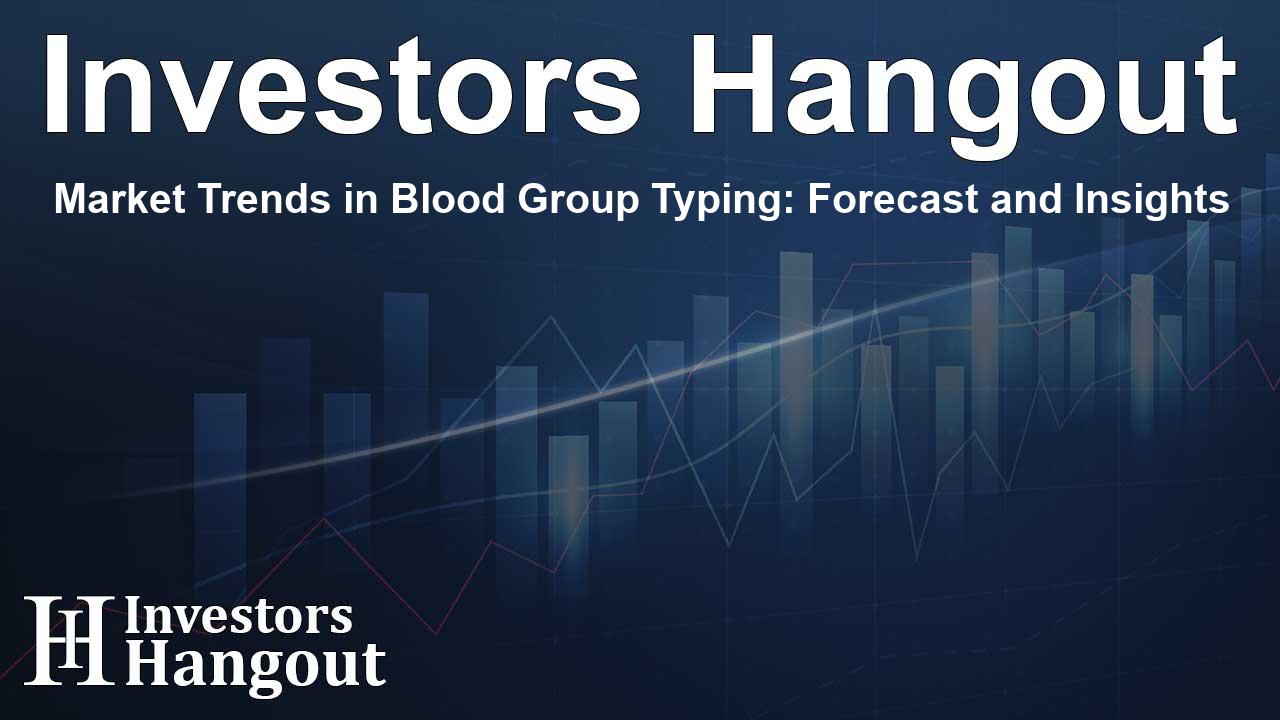Market Trends in Blood Group Typing: Forecast and Insights

Blood Group Typing Market Growth: An Overview
The blood group typing market has witnessed tremendous growth in recent years, primarily driven by the increasing need for safe blood transfusions and organ transplants. Experts estimate that by the end of this forecast period, the market size could reach USD 4.82 billion, a significant increase from USD 2.26 billion in 2023. This growth, at a compound annual growth rate (CAGR) of 8.80%, showcases just how crucial blood typing has become in our medical landscape.
Drivers of Market Growth
Several factors contribute to the robust growth of the blood group typing sector. The escalating demand for safe blood transfusions and organ transplantation is at the forefront. With advancements in medical technologies, processes such as molecular genotyping and artificial intelligence-powered analyzers are steering the way for greater accuracy and efficiency in blood typing procedures. All these developments reflect an ongoing transformation in the healthcare industry, underscoring the importance of precise blood group identification.
Technological Advancements
The integration of advanced technologies in blood typing significantly boosts the market. Automated platforms streamline the testing process, enhancing speed and reliability. These innovations also emphasize the push for personalized medicine, ensuring that blood group profiling goes hand in hand with tailored patient care.
Regional Insights and Trends
In terms of regional dominance, North America continues to lead the market. The U.S. blood typing market alone is expected to grow from USD 0.92 billion in 2023 to an estimated USD 1.92 billion by 2032, benefiting from a well-established healthcare infrastructure and high voluntary blood donation rates backed by organizations such as the American Red Cross.
Emerging Markets
Meanwhile, the Asia Pacific region shows promise for rapid growth during the forecast period. Expanding healthcare investments, increasing incidents of chronic diseases, and rising awareness regarding prenatal blood typing among expectant mothers position this region for significant advancements. Tailored public health programs and an inclination towards safe transfusion practices are further catalysts for this growth.
Segmentation of the Blood Group Typing Market
The blood group typing market can be segmented by product types, techniques used, and the type of tests conducted.
Product Segmentation
- Consumables
- Instruments
- Services
Among these segments, the consumables category dominates the market, contributing significantly to revenue. The repetitive demand for kits and reagents crucial for blood typing procedures is a major factor behind this dominance.
Technique and Test Type Segmentation
- Assay-based Techniques
- PCR-based Techniques
- Massively Parallel Sequencing Techniques
- Others
When it comes to test types, the ABO blood tests segment leads the market. This can be attributed to its fundamental role in ensuring the safety of transfusions and organ transplants, making it a routine practice in hospitals and blood banks worldwide.
Major Players in the Blood Typing Market
Several recognized companies are pivotal in shaping the blood group typing market landscape. Companies such as Grifols S.A., Merck KGaA, Bio-Rad Laboratories, and Immucor Inc. represent some of the leading names that influence both technological advancements and market trends through their innovative products.
Competitive Landscape
These major players continually invest in research and development, enhancing the efficacy of blood typing and expanding their service range to meet the ever-increasing demands of healthcare professionals across the globe.
Conclusion and Future Outlook
The future of the blood group typing market is bright, with opportunities for substantial growth driven by technological innovations, increasing healthcare demands, and expanding markets. The critical importance of accurate blood typing in the context of both medical emergencies and planned procedures underscores the market's relevance. Stakeholders within the healthcare system must remain attuned to these dynamics to harness the full potential of this evolving field.
Frequently Asked Questions
What factors are contributing to the growth of the blood group typing market?
The increasing demand for safe blood transfusions and organ transplants, coupled with technological advancements, are the primary drivers of market growth.
Where is the blood typing market experiencing the fastest growth?
The Asia Pacific region is projected to register the fastest growth due to healthcare investments and increased awareness of safe transfusion practices.
Which segment dominates the blood group typing market?
The consumables segment dominates the market share due to the ongoing need for testing kits and reagents in various medical settings.
Who are the key players in the blood group typing market?
Key players include Grifols S.A., Merck KGaA, Bio-Rad Laboratories, and Immucor Inc., among others.
What is the expected market size for blood group typing by 2032?
By 2032, the blood group typing market is projected to reach USD 4.82 billion.
About The Author
Contact Dylan Bailey privately here. Or send an email with ATTN: Dylan Bailey as the subject to contact@investorshangout.com.
About Investors Hangout
Investors Hangout is a leading online stock forum for financial discussion and learning, offering a wide range of free tools and resources. It draws in traders of all levels, who exchange market knowledge, investigate trading tactics, and keep an eye on industry developments in real time. Featuring financial articles, stock message boards, quotes, charts, company profiles, and live news updates. Through cooperative learning and a wealth of informational resources, it helps users from novices creating their first portfolios to experts honing their techniques. Join Investors Hangout today: https://investorshangout.com/
The content of this article is based on factual, publicly available information and does not represent legal, financial, or investment advice. Investors Hangout does not offer financial advice, and the author is not a licensed financial advisor. Consult a qualified advisor before making any financial or investment decisions based on this article. This article should not be considered advice to purchase, sell, or hold any securities or other investments. If any of the material provided here is inaccurate, please contact us for corrections.
